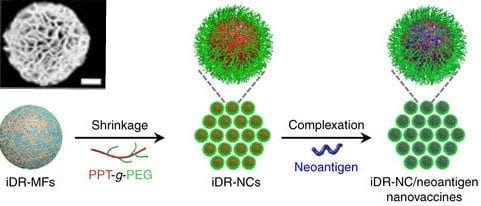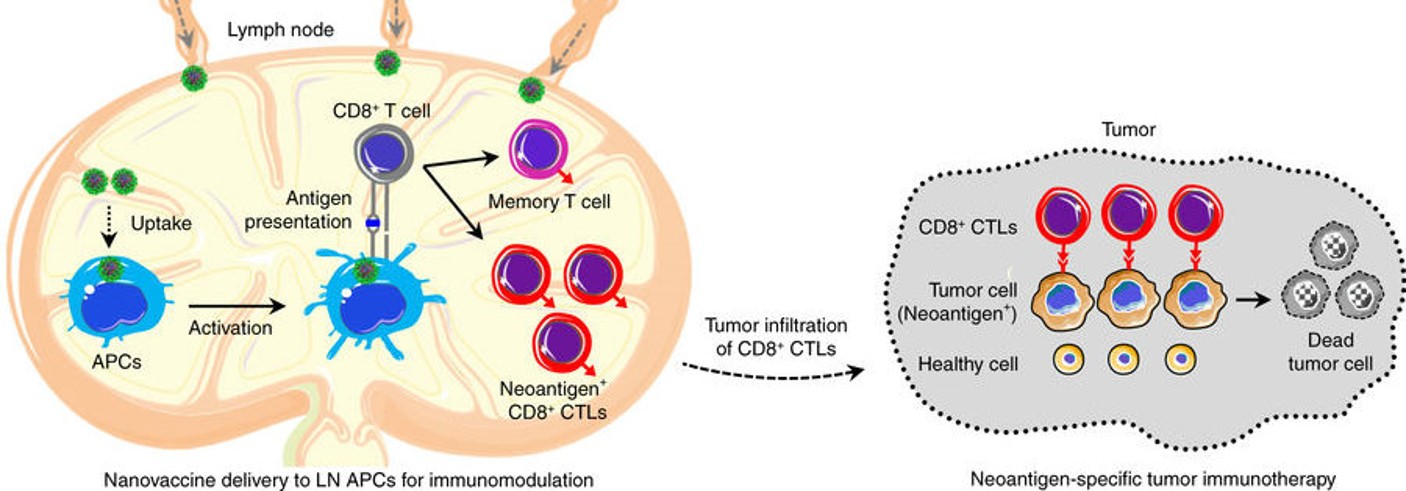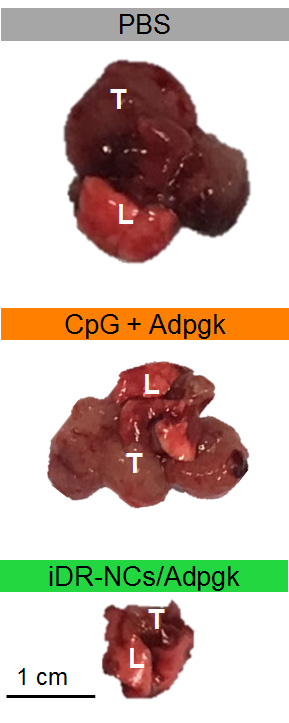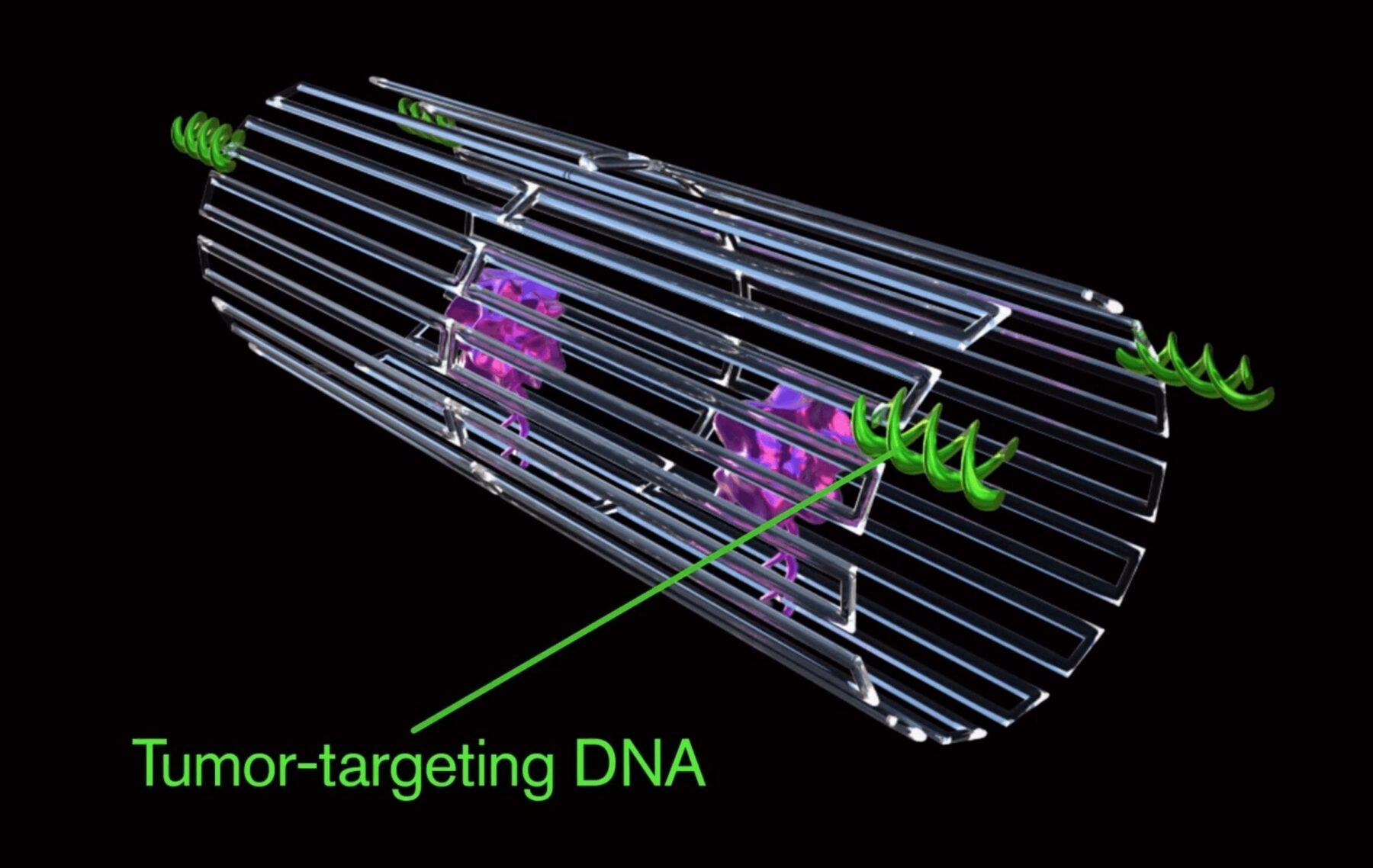
Vaccine stimulates multi-pronged immune attack, inhibits tumor-induced immune suppression
Scientists are using their increasing knowledge of the complex interaction between cancer and the immune system to engineer increasingly potent anti-cancer vaccines. Now researchers at the National Institute of Biomedical Imaging and Bioengineering (NIBIB) have developed a synergistic nanovaccine packing DNA and RNA sequences that modulate the immune response, along with anti-tumor antigens, into one small nanoparticle. The nanovaccine produced an immune response that specifically killed tumor tissue, while simultaneously inhibiting tumor-induced immune suppression. Together this blocked lung tumor growth in a mouse model of metastatic colon cancer.
The molecular dance between cancer and the immune system is a complex one and scientists continue to identify the specific molecular pathways that rev up or tamp down the immune system. Biomedical engineers are using this knowledge to create nanoparticles that can carry different molecular agents that target these pathways. The goal is to simultaneously stimulate the immune system to specifically attack the tumor while also inhibiting the suppression of the immune system, which often occurs in cancer patients. The aim is to press on the gas pedal of the immune system while also releasing the emergency brake.
A key hurdle is to design a system to reproducibly and efficiently create a nanoparticle loaded with multiple agents that synergize to mount an enhanced immune attack on the tumor. Engineers at the NIBIB report the development and testing of such a nanovaccine in the November issue of Nature Communications.1
Making all the parts fit
Guizhi Zhu, Ph.D., a post-doctoral fellow in the NIBIB Laboratory of Molecular Imaging and Nanomedicine (LOMIN) and lead author on the study, explains the challenge. “We are very excited about putting multiple cooperating molecules that have anti-cancer activity into one nanovaccine to increase effectiveness. However, the bioengineering challenge is fitting everything in to a small particle and designing a way to maintain its structural integrity and biological activity.”
Zhu and his colleagues have created what they call a “self-assembling, intertwining DNA-RNA nanocapsule loaded with tumor neoantigens.” They describe it as a synergistic vaccine because the components work together to stimulate and enhance an immune attack against a tumor.
Small green nanovaccine particles deliver the tumor neoantigen to the lymph nodes (left) to stimulate the expansion of cytotoxic T lymphocytes (CTLs) specific for the tumor. The CTLs infiltrate the tumor at the right and kill tumor cells carrying the neoantigen (gray) but do not harm normal healthy cells (yellow). Credit: Zhu, et al. Nat Comm, November 2017.
In addition to engineering a system where the DNA, RNA and tumor neoantigens self-assemble into a stable nanoparticle, an important final step in the process is shrinking the particle. Zhu explains: “Shrinking the particle is a critical step for activating an immune response. This is because a very small nanoparticlecan more readily move through the lymphatic vessels to reach the parts of the immune system such as lymph nodes. A process that is essential for immune activation.”
The method for shrinking also had to be engineered. This was achieved by coating the particle with a positively charged polypeptide that interacts with the negatively charged DNA and RNA components to condense it to one-tenth of its original size.
Testing the vaccine
Tumor (T) and lung (L) from control treated mice (top two) and nanovaccine treated mice (bottom) show a 10-fold reduction in tumor tissue in the lung of the nanovaccine treated animal. Credit: Zhu, et al. Nat Comm, November 2017.
The nanovaccine was injected under the skin of the mice 10, 16, and 22 days after the colon cancer cells were injected. To compare to the nanovaccine, two control groups of mice were analyzed; one group was injected with just the DNA and the neoantigen in solution but not formed into a nanovaccine particle, and the second control group was injected with an inert buffer solution.
At 40 days into the experiment, lung tumors from the nanovaccine-treated and the control groups were assessed by PET-CT imaging, and then removed and weighed. In mice treated with the nanovaccine, tumors were consistently one tenth the size of the tumors that were found in mice in both control groups.
Further testing revealed that mice receiving the nanovaccine had a significant increase in circulating cytotoxic T lymphocytes (CTLs) that specifically targeted the neoantigen on the colon cancer cells. CTLs are cells that attack and kill virus-infected cells and those damaged in other ways, such as cancerous cells.
An important aspect of the nanovaccine approach is that it mounts an anti-tumor immune response that circulates through the system, and therefore is particularly valuable for finding and inhibiting metastatic tumors growing throughout the body.
The researchers view their nanovaccine as an important part of eventual therapies combining immunotherapy with other cancer killing approaches.
Learn more: “Swiss army knife” nanovaccine carries multiple weapons to battle tumors
The Latest on: Nanovaccine
[google_news title=”” keyword=”nanovaccine” num_posts=”10″ blurb_length=”0″ show_thumb=”left”]- 2023 Senior Design Presentations Scheduleon April 26, 2024 at 10:38 am
Alongside robust computational software, we designed a high-throughput epitope identification and mapping program to aid antigen optimization and nanovaccine generation. This program finds highly ...
- Save content toon July 5, 2023 at 7:05 am
e.g. natural or synthetic bone mimetic materials or nanovaccine biomineralization Authors wishing to submit to this collection should do so through the Geo-Bio Interfaces submission and peer review ...
- Dr Sara Cordeiroon July 4, 2021 at 9:36 pm
as well as in basic immunology assays for the evaluation of nanovaccine candidates. In 2017, Sara joined Prof. Ryan Donnelly's lab at Queen's University Belfast for a postdoc, where she focused on the ...
- Translational Immunology Program (TRIMM)on February 25, 2021 at 4:06 am
The program joins together 13 active research groups in different career phases (10 PIs and 4 junior associate PIs) and is complemented with 8 clinical research teams led by the clinical researchers.
via Google News and Bing News












